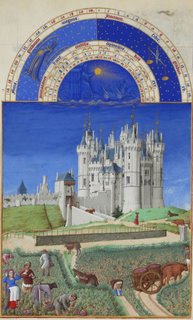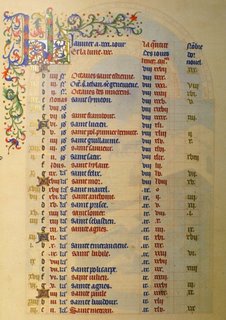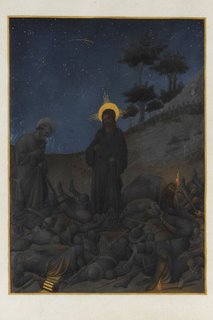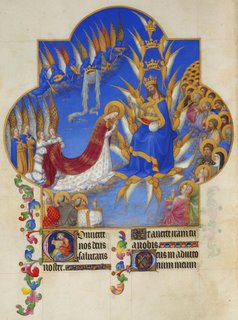Les Très Riches Heures du Duc de Berry, by the Limbourg brothers, et al. Ink on vellum, circa 1410-1490.
 Well I was browsing Wikimedia Commons today when I saw that they have an awesome collection of images from Les Très Riches Heures du Duc de Berry. I don't speak French, but I'm told that translates roughly as The Very Sumptuous Hours of the Duke of Berry. Now let's start with some definitions so you know what I'm talking about.
Well I was browsing Wikimedia Commons today when I saw that they have an awesome collection of images from Les Très Riches Heures du Duc de Berry. I don't speak French, but I'm told that translates roughly as The Very Sumptuous Hours of the Duke of Berry. Now let's start with some definitions so you know what I'm talking about.The most important book in the early Christian church was, naturally, the Bible. In the days before the printing press, not many people could own Bibles because they were so expensive - it takes a lot of time and labor to copy an entire Bible, and make it all pretty with pictures and that fancy Gothic handwriting. (I don't know this from experience, but if you don't believe me, try it yourself and let me know how it goes.) So if people wanted to own a religious manuscript of some kind, they had to find something a lot shorter. So a new book was put together especially for the common, everyday church members: the Psalter, so-called because the only book of the Bible it contains is the Book of Psalms. Psalters contain a few other important things as well, like calendars and special prayers.
Well, people got tired of carrying around all the Psalms, so manuscript makers started leaving those out, and making books that just contained the prayers and the calendar. And they called it: The Book of Hours. (Ta da.) It's called the Book of Hours because the most important prayers it contains are the Hours of the Virgin, special prayers that are said throughout the day to the Virgin Mary. It also contains the Office of the Dead, a prayer that is said to help dead friends get through purgatory faster, and the Penitential Psalms, which are recited to help people resist temptation to commit one of the Seven Deadly Sins. Some Books of Hours were specifically designed for children, to help them learn to read. These books were given the nickname "primers," because the first hour that you were supposed to say a prayer to the Virgin was the hour of Prime (which was roughly around 6 AM).
Now that I done learned you about Books of Hours, let me tell you about the Very Sumptuous Hours of Jean, the Duke of Berry. Jean was a wealthy dude - his brother was French king Charles V. And Jean liked to collect books. He owned about 14 Bibles, 16 Psalters, 18 Breviaries, 6 Missals and 15 Books of Hours. (A Breviary is a special prayer book designed to be used only by the clergy, and a Missal contains all of the words of the Mass.) The Very Sumptuous Hours is regarded as the highlight of the Duke's collection. Now Les Très Riches Heures is a group collaboration - the best parts are credited to the three Limbourg brothers, Paul, Hermann and Jean. But all three Limbourg brothers died in 1416, before the book was finished. (They were probably killed by the plague.) So Très Riches Heures was finished by a bunch of other artists, primarily by Jean Colombe. (I guess back then everybody and their dog was named Jean.)
I'm not sure, but I believe the only part of the Sumptuous Book of Hours that was finished by the Limbourg brothers is the calendar - it's usually pictures from the calendar that you see in art history books, primarily the illustrations of the twelve months of the year. The picture I posted up at the top is the illustration for the month of September. Each monthly illustration shows people engaging in activities that were primarily done during that month. In September's picture, we see peasants harvesting grapes and carrying them into the Chateau de Saumur, a castle owned by the Duke.
 The months are nice, but I think the rest of the book is just as beautiful, especially the pages with text. To the left is one of the text pages of the calendar. (This is the page for Janvier, aka January - you can see the illustration for Fevrier, or February, is on the reverse side.) Medieval calendars are pretty complex - this was made before the Gregorian calendar came along and made everything easy to understand. The text that is in the center column, the longest line, gives the names of all of the different religious holy days. Because this is a very sumptuous Book of Hours, the L bros could get really lavish and write all of the words in red and blue. In your standard Book of Hours, though, most of the days were written in black or brown, with red reserved for the really special feast days - this is where we get the term "red-letter day." (Pretty cool, eh? Share that with the next good-looking person you meet, and see how easy it is to score a date tonight.) I won't spend time trying to explain the rest of the calendar, but see that second column, the one that lists the letters A-G over and over again? Those are the Dominical Letters, and were used to tell what day of the week it was. For example, during the year 1410, the Dominical Letter was E, which means each day with the letter E next to it was a Sunday.
The months are nice, but I think the rest of the book is just as beautiful, especially the pages with text. To the left is one of the text pages of the calendar. (This is the page for Janvier, aka January - you can see the illustration for Fevrier, or February, is on the reverse side.) Medieval calendars are pretty complex - this was made before the Gregorian calendar came along and made everything easy to understand. The text that is in the center column, the longest line, gives the names of all of the different religious holy days. Because this is a very sumptuous Book of Hours, the L bros could get really lavish and write all of the words in red and blue. In your standard Book of Hours, though, most of the days were written in black or brown, with red reserved for the really special feast days - this is where we get the term "red-letter day." (Pretty cool, eh? Share that with the next good-looking person you meet, and see how easy it is to score a date tonight.) I won't spend time trying to explain the rest of the calendar, but see that second column, the one that lists the letters A-G over and over again? Those are the Dominical Letters, and were used to tell what day of the week it was. For example, during the year 1410, the Dominical Letter was E, which means each day with the letter E next to it was a Sunday.I'm going to throw in a few more random pages because I think they're pretty. If you think these pictures are cool, click on that "Wikimedia Commons" link that I've so helpfully placed in the bar to the right, search for "Les Très Riches Heures" and take a look at some of the other pretty pages. If you want to know more about the Book of Hours, visit the Hypertext Book of Hours, or find yourself a copy of Painted Prayers: The Book of Hours in Medieval and Renaissance Art, a great book by Roger S. Wieck that really explains all of this stuff well, and has some beautiful illustrations from books owned by The Pierpont Morgan Library.
 This is a lovely picture of Christ in Gethsemane. (Yes, it's supposed to be that dark - this isn't just a bad photo.) I think the gold, especially the stars in the sky, looks really nice against the dark blue.
This is a lovely picture of Christ in Gethsemane. (Yes, it's supposed to be that dark - this isn't just a bad photo.) I think the gold, especially the stars in the sky, looks really nice against the dark blue. This image shows the Coronation of the Virgin, and really shows off the awesome, bright colors that were used. That blue is made from crushed lapis-lazuli - the color it makes is gorgeous, but it's also really expensive. (The Arena Chapel, painted by Giotto, also uses blue made from lapis.)
This image shows the Coronation of the Virgin, and really shows off the awesome, bright colors that were used. That blue is made from crushed lapis-lazuli - the color it makes is gorgeous, but it's also really expensive. (The Arena Chapel, painted by Giotto, also uses blue made from lapis.) This last one is of Judas hanging himself. I mostly include it because I think the embellishment around the text is amazing. I suppose I also enjoy the fact that it's slightly grotesque.
This last one is of Judas hanging himself. I mostly include it because I think the embellishment around the text is amazing. I suppose I also enjoy the fact that it's slightly grotesque.




1 Comments:
......wow....it's true....you are very cool!
Post a Comment
<< Home